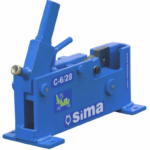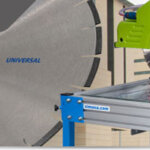For those embarking on a tiling project, whether it’s flooring, a bathroom wall, or a countertop, a wet tile saw stands out for delivering quick, professional results. While manual tile cutters can be used for professionals or small jobs, they come with certain limitations. If you’re inexperienced, you might waste tiles by breaking them incorrectly, and even when done right, the cut won’t be as clean as one made with a tile saw.
If you’re new to using a wet tile saw, you’ll find it’s not overly complicated. This article aims to help you decide between a tile cutter and a wet saw for your specific needs.
Contents
Manual tile saw vs. wet saw: how to use them and their applications
Novices might find using a manual tile cutter challenging. The process involves aligning the tile so a small blade can run along the desired cutting line. The user must press and slide the blade to score the tile, then carefully snap it along the score line. This requires a certain level of finesse and technique to achieve a good result.
On the other hand, a wet tile saw is significantly more user-friendly. Often, especially when renting a tile saw, setup concerns are minimal since the saw typically comes with an appropriate diamond blade already attached. Your primary task will be to fill the water tank and ensure the saw is either safely plugged into an outlet if it’s electric or placed in a well-ventilated area if it has a petrol motor.
Before beginning any cutting, check for signs of wear or damage on the saw, and ensure water is being pumped over the blade when the saw is powered on. This water flow is essential for safety and for maintaining the blade and machine’s longevity.
Accurate measurement and marking of the tiles are crucial before proceeding. Once prepared, place the tile on the wet saw’s sliding table, aligning the blade with your cut line. Turn on the saw, ensure water is flowing over the diamond blade, and slowly slide the table toward the blade. The diamond particles on the blade will grind through the tile, creating a clean, professional cut.
Certain tiles may chip at the end. If this occurs, apply gentle inward pressure to the tile’s sides as the blade finishes the cut.
So, tile cutter or wet saw?
Having reviewed the tips in this article, the decision between a tile cutter and a wet saw comes down to your specific needs. For small projects or occasional tile cuts, a manual tile cutter may suffice. You might break a few tiles initially, but with practice and patience, you can achieve good results. Thus, a manual tile cutter is often recommended as “the best tool to have at home for cutting some tiles.”
However, for large or professional projects, a wet saw is the superior choice. It offers speed, precision, and efficiency, making it ideal for extensive tiling work. While the final decision rests with you, we advise opting for a wet saw if you seek professional-grande outcomes.





